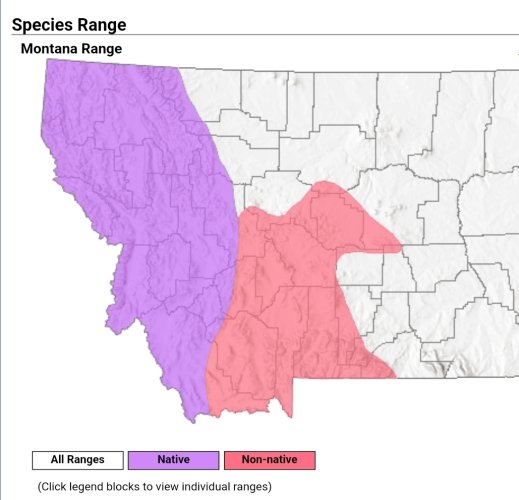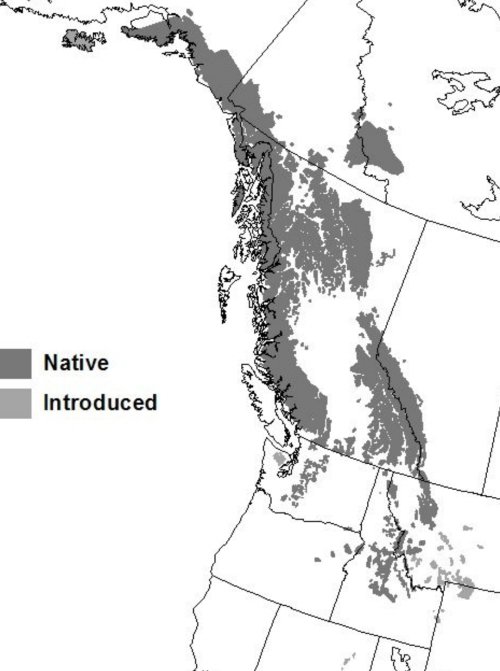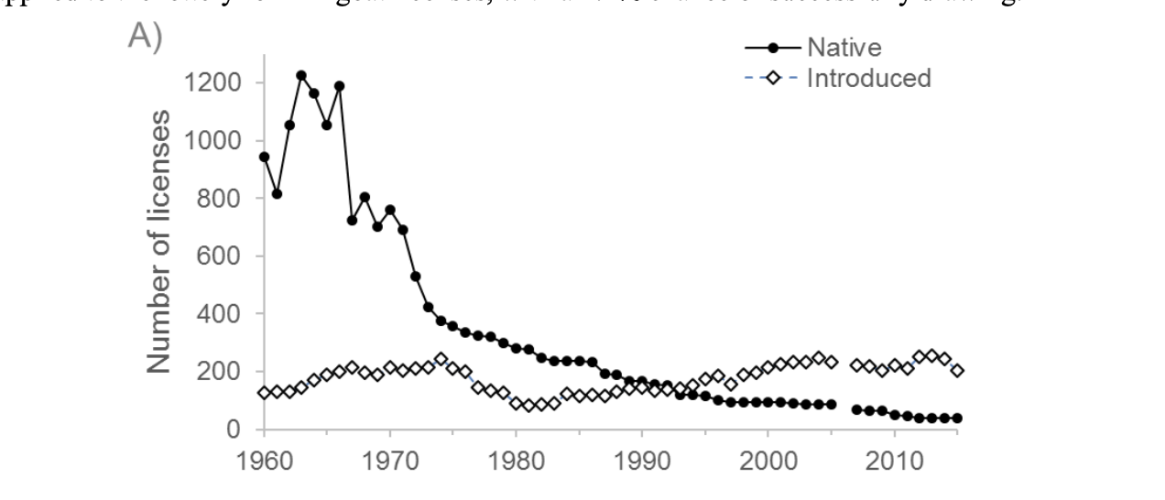Navigation
Install the app
How to install the app on iOS
Follow along with the video below to see how to install our site as a web app on your home screen.
Note: This feature may not be available in some browsers.
More options
You are using an out of date browser. It may not display this or other websites correctly.
You should upgrade or use an alternative browser.
You should upgrade or use an alternative browser.
The Future of “Big 3” Hunting in Montana.
- Thread starter Nameless Range
- Start date
It would be interesting to have a graph of areas hunting personalities feature on their content, the draw odds getting jacked up or the populations getting hammered, if let’s say tags were plentiful. I would think some skin in the game with upfront tag costs would decrease demand a little for the big three, but the train has gone off the rails. I don’t trust mtfwp to not let things go right back to the brink.
Luke_with_a_lab
Well-known member
Wow that really interesting to look at, thanks for sharing. Really makes you wonder about something like the sheep foundation and all their money. What are all those dollars going to?
I don’t know about the sheep or goats, but the habitat in northwest Montana really sucks for wildlife. These forests have large areas devoid of animals, except for deer and bear/predators. The stuff is so thick nothing can feasibly move trough it or find decent feed.
In 2001 I drew a nonresident big game combo and hunted the southern end of the Snowcrest and seen about half a dozen different bulll moose and lots of elk. I bet today it’s hit or miss on finding a bull moose.
In 1995 I bear hunted near Styker MT and we seen tons of mule deer, whitetail, elk, bear, grouse, and everything else. The forest were relatively young clear cuts and there was tons of available browse, grasses.
The Forest now are super thick with tons of downfall just ready for the next burn, and no significant numbers of animals.
Sorry to be a downer but the animals aren’t coming back, we have too many impacts on the landscape and wildlife communities. Like I’ve said before, I’m ready for a new heaven and new earth
In 2001 I drew a nonresident big game combo and hunted the southern end of the Snowcrest and seen about half a dozen different bulll moose and lots of elk. I bet today it’s hit or miss on finding a bull moose.
In 1995 I bear hunted near Styker MT and we seen tons of mule deer, whitetail, elk, bear, grouse, and everything else. The forest were relatively young clear cuts and there was tons of available browse, grasses.
The Forest now are super thick with tons of downfall just ready for the next burn, and no significant numbers of animals.
Sorry to be a downer but the animals aren’t coming back, we have too many impacts on the landscape and wildlife communities. Like I’ve said before, I’m ready for a new heaven and new earth
BuzzH
Well-known member
So, what's the excuse in the Bitterroot and Upper Clarks Fork both had massive burns? Ashland Country has burned a bunch too.I don’t know about the sheep or goats, but the habitat in northwest Montana really sucks for wildlife. These forests have large areas devoid of animals, except for deer and bear/predators. The stuff is so thick nothing can feasibly move trough it or find decent feed.
In 2001 I drew a nonresident big game combo and hunted the southern end of the Snowcrest and seen about half a dozen different bulll moose and lots of elk. I bet today it’s hit or miss on finding a bull moose.
In 1995 I bear hunted near Styker MT and we seen tons of mule deer, whitetail, elk, bear, grouse, and everything else. The forest were relatively young clear cuts and there was tons of available browse, grasses.
The Forest now are super thick with tons of downfall just ready for the next burn, and no significant numbers of animals.
Sorry to be a downer but the animals aren’t coming back, we have too many impacts on the landscape and wildlife communities. Like I’ve said before, I’m ready for a new heaven and new earth
How about the Bob Marshall? Nearly all of it is burned. Frank Church in Idaho all burned.
I don't disagree with you on late succession in some areas and deadfall being a problem, but this isn't an across the board issue on large parts of habitat in Montana. Yet, even in the early/mid succession regions, the populations of moose, elk, goats, sheep, etc. are still in the shit.
Also, specific to Mountain Goats, the West side of the Bitterroot and Sapphires have sucked ass for a long time for goats and those habitats above timberline are not as influenced by sub-alpine climax vegetation or fire frequency.
Plus, late succession/climax in lodgepole and sub-alpine fir are commonly 150-250 years between stand replacing disturbance. These crap populations in some of those areas is a recent deal and I would argue nothing to do with the habitat.
Even in the LP stands that suffered from MPB, those kind of stand replacing disturbance are not all that uncommon in historic records. What I would argue is that the stand age when it happened is much younger. I think there's a reason for that, but I don't want your hair to catch on fire that its most certainly related to climate change.
I think tick and arterial worms in moose is a climate induced problem as well. I also even think the EHD outbreaks are much worse now also largely due to climate.
I also agree with you that we may be past the time to fix some of it, and even if we wanted to, most don't have the stomach for what it would take. I think some of it can/could be addressed and reversed. I also think we will still have animals on the landscape, when change happens, there are always winners and losers.
IMO, we reap what we sow...and we're going to reap the whirlwind we've ignored and have chosen to nothing about.
I hope the next generation is smarter...because we've dropped the ball, big-time.
atlas
Well-known member
- Joined
- Feb 15, 2022
- Messages
- 480
I can't believe they offer nanny tags for places like the Crazies when there are mountain ranges west of the divide where goats have been extirpated.
Bambistew
Well-known member
How many goat herds were introduced? Most of MT isn't really great goat habitat, IMO.
atlas
Well-known member
- Joined
- Feb 15, 2022
- Messages
- 480
Well, the crazies herd was introduced but from what I understand they are native to much of the western part of the state, including many areas they are now absent.How many goat herds were introduced? Most of MT isn't really great goat habitat, IMO.
Bambistew
Well-known member
I don't know for sure, where their true range extended, but I believe all the goats around YNP by 100 mile radius are introduced. Goats are not native to WY, CO, NV or UT. I believe the only native herds in MT were around glacier NP. My grandfather helped haul mountain goats via pack horse for introduction into the Madison range in the early 50s.Well, the crazies herd was introduced but from what I understand they are native to much of the western part of the state, including many areas they are now absent.
BigHornRam
Well-known member
Most every herd east of the continental divide.How many goat herds were introduced? Most of MT isn't really great goat habitat, IMO.
Last edited:
D
Deleted member 48080
Guest
I don't know for sure, where their true range extended, but I believe all the goats around YNP by 100 mile radius are introduced. Goats are not native to WY, CO, NV or UT. I believe the only native herds in MT were around glacier NP. My grandfather helped haul mountain goats via pack horse for introduction into the Madison range in the early 50s.
We have way more native range than just around Glacier.


Last edited by a moderator:
Especially when the herd has declined in recent years. I don't see the reasoning for continuing to kill nannies when they had to cut overall tag numbers.I can't believe they offer nanny tags for places like the Crazies when there are mountain ranges west of the divide where goats have been extirpated.
Probably have to kill them to save them. Seems like that’s a popular approach these days.Especially when the herd has declined in recent years. I don't see the reasoning for continuing to kill nannies when they had to cut overall tag numbers.
BuzzH
Well-known member
The MTFWP completely destroyed the native goats in Montana, over hunted them to near extinction and certainly beyond recovering.
Climate change has caused the tick load on moose in the NE to reach just about about a crisis level. I only see it getting worse and can’t imagine a solution.
Speaking of sheep. The record money that has flowed into private “conservation “ orgs like WSF the only place we have seen more tags are on the their auction blocks. I am waiting mission statement change, putting and keeping more sheep tags in our “ donors “ pockets would be appropriate
Speaking of sheep. The record money that has flowed into private “conservation “ orgs like WSF the only place we have seen more tags are on the their auction blocks. I am waiting mission statement change, putting and keeping more sheep tags in our “ donors “ pockets would be appropriate
D
Deleted member 48080
Guest
The MTFWP completely destroyed the native goats in Montana, over hunted them to near extinction and certainly beyond recovering.
While I definitely think that's true in some spots like 240, I don't think it's very smart to simplify it that much. There's populations that have never been hunted that are struggling just as badly. There's something deeper going on than just hunting.
atlas
Well-known member
- Joined
- Feb 15, 2022
- Messages
- 480
I listened to a lifelong goat researcher give a talk at UM a few years ago. I think the Great Burn Alliance put it on. The researcher said a lot of the overhunting happened later compared to species like deer and elk. If I remember it right lot of it happened in the 1960s- 1970s as four-wheel drive became more available and forest service roads made it higher up the mountain. The tags weren't cut in time to save them from a long steady decline.

here's a report from Montana that gets into the declines.

here's a report from Montana that gets into the declines.
BuzzH
Well-known member
Well, its safe to say they completely destroyed the Rattlesnake, Sapphires, Bitterroots, and the Bob Marshall, Missions with over hunting.While I definitely think that's true in some spots like 240, I don't think it's very smart to simplify it that much. There's populations that have never been hunted that are struggling just as much. There's something deeper going on than just hunting.
Where was proper application of hunting applied to a herd that is struggling?
I've read too, that once a herd is reduced to a certain point, they just don't and will not ever recover. I think the herds I mentioned above are in that category, beyond recovery. Transplanting to augment those herds also tend to fail.
What bothers me more, is that there were studies being conducted clear back in the 1960's and 1970's on hunting pressure and how it impacts native goat herds. Apparently the MTFWP thought they new better.
The "best" we'll ever do with goats in Montana is to hunt the transplanted herds, they are an entirely different deal when placed in non-native habitat.
The native goats are going to be remnant populations at best, that may hang on for a while, but they should never be hunted again.
Not to keep beating a dead...goat, as it were, but when I first applied for the Bitterroot it was 75 goat tags valid for the entire area. The FWP didn't know shit from clay about how to manage goats. Not only was that grossly too many tags, but they didn't have a clue about population. Then they reduced it to 50, then sometime in the mid-80's finally broke it out by drainage, to about 25 total tags.
A friend of mine drew the Bitterroots in the late 90's and asked the area biologist about the goats in the drainage he drew. He asked how many goats, age structure, the usual questions.
He was told to talk to Duncan Gilchrist and he knew about the goats there than the biologist did. At least he was honest.
I'm not inclined to give the FWP a pass on their gross mismanagement of mountain goats.
The maximum number of tags issued for most of the native herds should have been 1-2 billy tags a year, some areas probably only 1 tag every second or even third year max.
Last edited:
atlas
Well-known member
- Joined
- Feb 15, 2022
- Messages
- 480
There are lots of other great figures and maps in this report as well.
D
Deleted member 48080
Guest
Where was proper application of hunting applied to a herd that is struggling?
I don't think that's something that can be quantified is it?
I'm not defending FWP's management. I'm just saying that when you have control populations that haven't been hunted also struggling, you can't 100% blame it on hunting.
Similar threads
- Replies
- 87
- Views
- 3K
- Replies
- 41
- Views
- 4K




